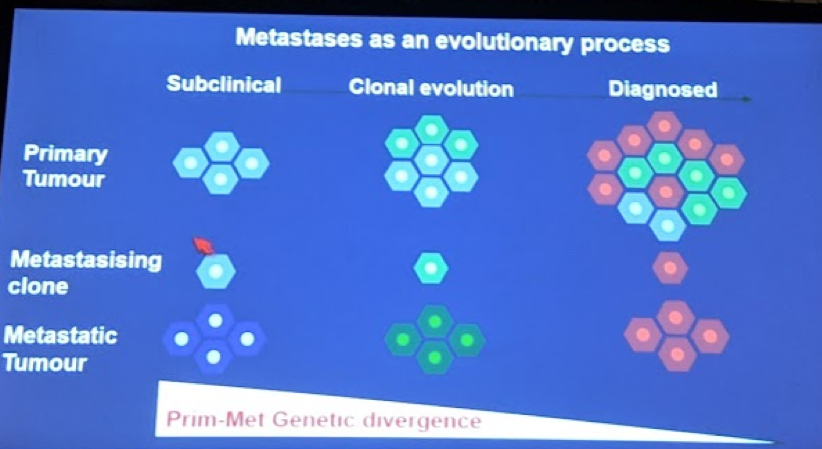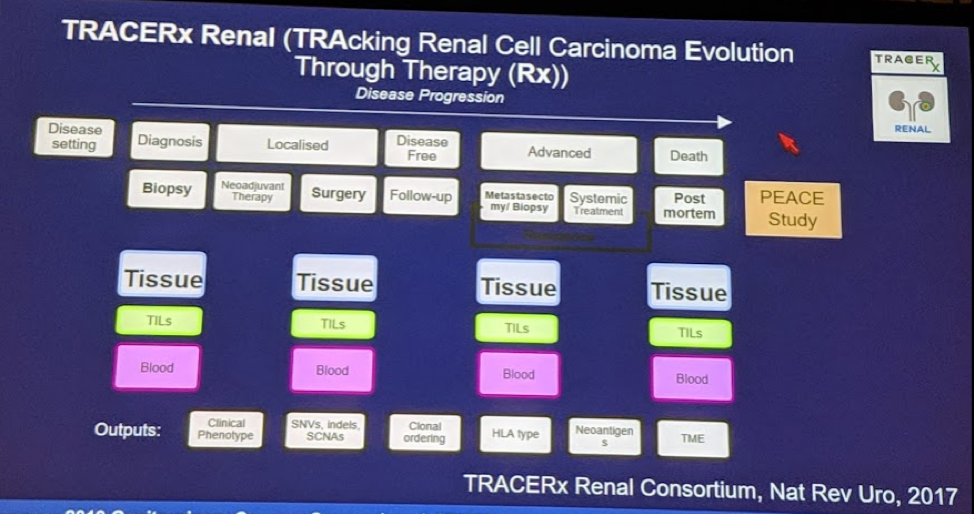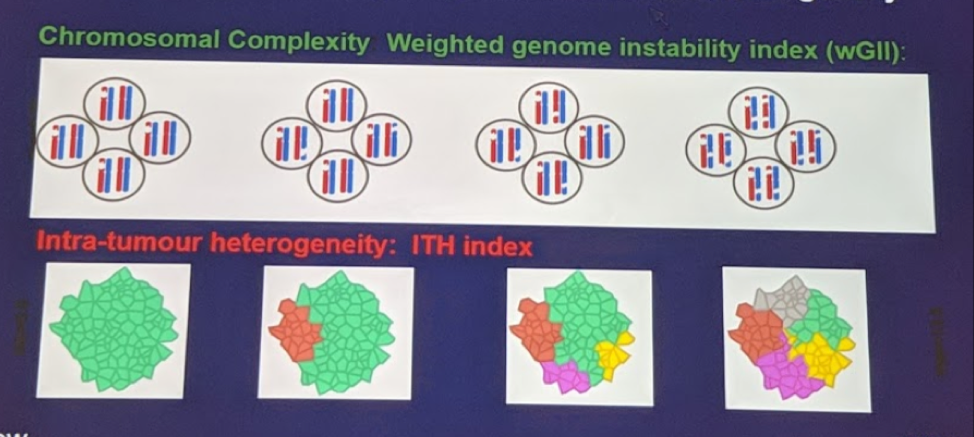As it relates to metastatic progression, there is a spectrum of how RCC can develop metastases and this captured well in this diagram:

On the left is an early primary tumor that sends off metastases of its monoclonal cell lineage. If this micrometastases survives, it likely has developed mutations that enabled survival – and therefore, is likely distinct from the primary tumor clones. As the primary tumor develops multiple clonal lines and heterogeneity increases, certain closes may become more aggressive and metastasis – however, while the primary is heterogeneous, there is a much high convergence in mutation spectrum between the primary tumor and the metastases. Understanding the timing and mutational burden of primary tumors and metastases may shed light on the process.
The bulk of her work is based on the TRACERx Renal Consortium in the UK – which is an amazing study that collects tissue and blood samples from RCC patients across multiple disease states, and captures metastatic biopsies as well as primary tumors. Importantly, they have also been able to get patients to agree to autopsy post-mortem, which has provided significant information from metastatic sites.

To date, they 100 cases, and from these, 1201 primary tumor biopsies and 335 metastatic biopsies. Using this early data (data continues to mature), they begin to address 2 main questions:
- What are the genomic features of metastases competent clones (clones that successfully metastases)?
- What are the genomic and evolutionary differences in primary tumors that associate with distinct patterns of metastases?

In the above patient, the entire “triangle” on the left represents the primary tumor on a time-scale (left is earlier). The blue clone represents the primary clone, and with time, additional clones developed (green, purple, red, yellow) with added mutations. The green clone went on to develop a metastasis. Keep this in mind for future examples.
When they compared patients who developed metastases versus those that didn’t, they found something interesting – the same spread of mutations was found in both cohorts. What distinguished patients who developed mutations are the overlap of multiple mutations together – increased chromosomal complexity! So, while no specific mutations were associated with metastatic progression, it was the combination of numerous mutations that led to metastases.
On meta-analysis, they identified two “high-risk” chromosomal loci selected in patients who developed metastases – loss of 9p21.3 and loss of 14q31.1. These will show up again later. They were highly prevalent in patients who developed metastases. Indeed, loss of 9p21.3 was never seen in patients that did not metastasize!
Next, they took this information about the metastases and went back to the primary tumors to answer the second question. They found two specific features of primary tumors were associated with poor outcomes and metastatic spread: chromosomal complexity (high degree of mutations) and intra-tumoral heterogeneity (high number of clones), depicted below:

Both were associated with worse outcomes in their dataset and validated using in the TCGA dataset.
Dr. Turajlic then went through 3 different clinical scenarios:
- Linear evolution, low ITH and low chromosomal complexity – no metastases

This patient had an early founder mutation and developed a primary tumor. However, it never developed additional mutations or ITH. It remained monoclonal with low metastatic potential. This pathway leads to good outcomes.
2. Branched evolution, high ITH and high chromosomal complexity – risk events occur late. This pathway leads to late development of additional mutations and branched evolution into multiple clones. These are associated with large primary tumors, highly vascularized, intermediate-high grade. However, slow metastatic progression, limited metastatic potential. Benefits from metastasectomy and cytoreduction, Long disease-free intervals.
3. Punctuated evolution, high ITH and high chromosomal complexity – multiple early mutations. These are the patients with large high-grade primaries and early metastases, present with metastatic disease. Rapid metastatic progression, don’t benefit from surgery. Note than the primary is all one clone that has all the mutations
She finished with some clinical examples that highlighted the above pathways. She also mentioned, appropriately, that multi-region profiling is not yet practical in clinical practice – yet, cell-free DNA and representative sequencing (using homogenized tumor tissue) may help overcome this. These are being evaluated currently.
References:
- Turajlic S et al. Tracking Cancer Evolution Reveals Constrained Routes to Metastases: TRACERx Renal. Cell. 2018 Apr 19;173(3):581-594.e12. doi: 10.1016/j.cell.2018.03.057. Epub 2018 Apr 12.
- Turajlic S et al. Deterministic Evolutionary Trajectories Influence Primary Tumor Growth: TRACERx Renal. Cell. 2018 Apr 19;173(3):595-610.e11. doi: 10.1016/j.cell.2018.03.043. Epub 2018 Apr 12.
Written By: Thenappan Chandrasekar, MD, Clinical Instructor, Thomas Jefferson University, (Twitter: @tchandra_uromd, @JEFFUrology), at the 2019 American Society of Clinical Oncology Genitourinary Cancers Symposium, (ASCO GU) #GU19, February 14-16, 2019 - San Francisco, CA


